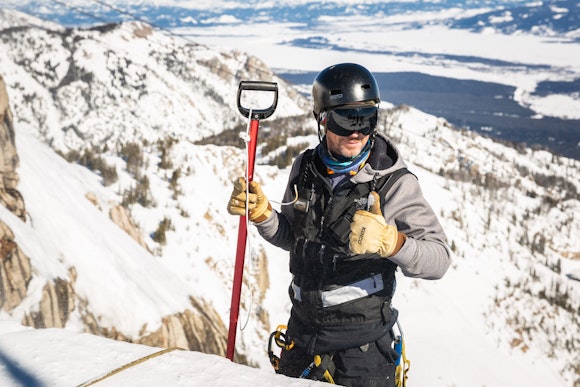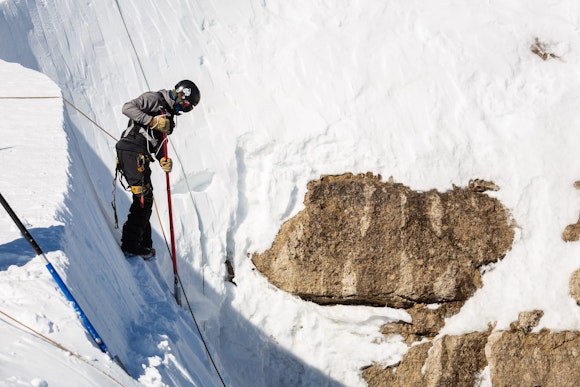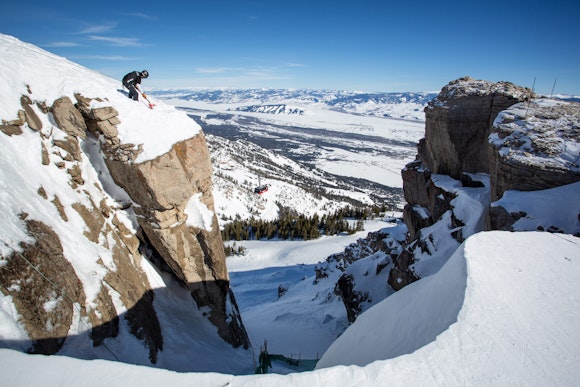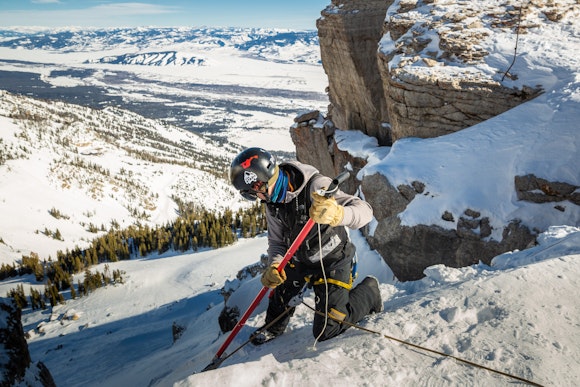Ranyon d’Arge is a hit maker, and he’s been making hits for the better part of three decades. I was lucky enough to watch him hone his craft first-hand in the late 90s, where I helped him concoct a booter on Teton Pass. At the time I skied and snowboarded 50/50, and I just happened to be skiing that day. For the record they both rule, and each has its own virtues. For instance, you’ll never pet the kitty on skis like you can on a snowboard. Argue if you like, but you’d be wrong.
Nevertheless, Ranyon finished the final touches and cranked a huge double back flip on his second go, and stuck the landing. No big deal. His passion, preternatural athleticism and drive for making (and hitting the) hits, has awarded him huge street cred to those in the know, not to mention executive producer bylines on all things park and pipe related at the Jackson Hole Mountain Resort.
Which leads us to his latest Opus: designing and producing the Kings and Queens venue. There’s something to be said about building a competition arena that always follows Mother Nature’s whims first. Not that it’s a bad thing. Jackson Hole has been getting pounded with big storms, and this week is no different. Snow and wind keep everyone on their toes. Ranyon and his crew have massaged the formidable steep skiing test piece for the upcoming freeride show, augmenting supplementary hits and features for the athletes to explore self-expression through the majesty of flight.
What makes Corbet’s ski so well? Lots of snow that’s available for transport, and a southwest flow. “We have a huge fetch that is Rendezvous Bowl,” says long-time patroller Rick “Frosty” Frost. “The southwest wind takes it off the bowl,” he says, “and just drops it right in.” The mouth of Corbet’s almost works like a wind fence, and with all the snow waterfalling into it, d’Arge and his crew have had their work cut out for them, tweaking, sheering, digging—lots of digging. “With all that cyclonic loading,” says d’Arge, “it’s just a machine for loading snow.”
Progress, however, ran into a snag last week. It’s called the North Wind, and it sucks. To be sure, it blows, but I digress. When the wind comes from the north or worse, the northeast, it scours the mountain in a way that leaves the desirable northern skiing aspects like Corbet’s bereft of snowfall that normally comes with moisture laden winter storms. Instead, what’s left is wind-robbed boilerplate, the antithesis for an event like Kings and Queens.
This is no small affair. d’Arge has been living in the couloir, making features for the event, and building what he calls “hats” for the trouble spots. “My primary two goals are safety and success,” he says. “And I want the athletes to be successful. You look at all the rocks right now—they’re usually jagged and sharp—they all have hats on them right now, eleven-inch hats to protect them.” Simply put, d’Arge and company have been shoveling, a lot, to best create an ideal setting for an event that is growing exponentially each year, so much so, that Red Bull will be live streaming it. Nonetheless, this week’s current storm is helping them out by bringing winds back the west, and depositing much needed snowfall back into Corbet’s.
d’Arge says he was left speechless by everything he saw go down at the first two events, and it filled him with the idea of what was still possible. He and his building crew also learned a few lessons. “Everything gets buried so fast,” he says, “So everything you build, you need to build twice as big because it just disappears.” This includes a final kicker at the bottom that arrives just in front of the locally known “Tensleep Roller”, a beached Moby Dick of a hit that propels jumpers on a long arc from one side of the hill to the other, where the spectators can more safely cheer on the competitors.
d’Arge says crafting a venue like this gets more specific each year. Some days he brings along a bunch of rookie help, while other days he needs people with climbing skills and can do specialty work in high consequence terrain. “A big game changer this year is working more and more with Travis Rice, “honestly,” he says. Rice was last year’s King, and is known throughout the industry for his vision and focus. “He has such an attention to detail, it’s like working with a scientist,” he says. Spending days with Rice on Kings and Queens, as well as Rice’s own Natural Selection project for the last two years have given d’Arge enough feature-building experience for the better part of a lifetime. “I’ve had an opportunity to learn from Travis and others who are at a skill level that is really high and cool to work with.”
When d’Arge was younger, he obsessed about the dark church that lived on the north side of Rendezvous Mountain. “Corbet’s was an adrenaline insomnia for quite a few years,” he admits. “I knew exactly what I wanted to do into it. I would think about it every night and it would keep me awake.” He’s taken that mindset and brought that imagination to life. “The fin out of the cave has always been one of the best kickers around,” he says. His acute knowledge of the topography puts him in the unique position of adding the right flourishes and enhancements to the arena to maximize the potential for the athletes to shine. “We’re taking the signature hits—specific rocks with snow on them—and just make them better.”




